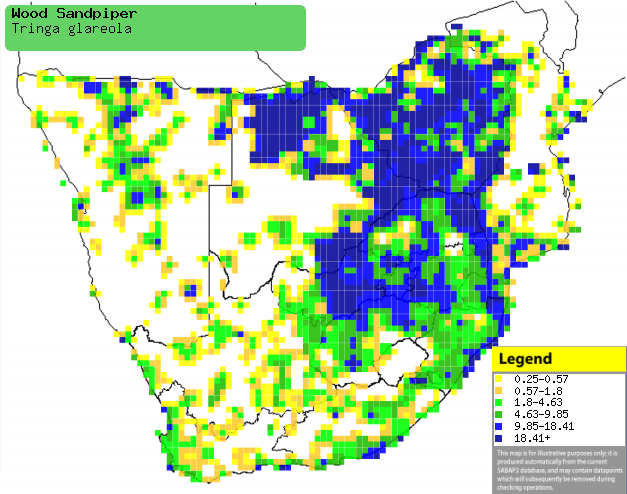|
Tringa glareola (Wood
sandpiper)
Bosruiter [Afrikaans]; Uthuthula (also applied to
Common sandpiper) [Xhosa]; Koe-koe-lemao (generic term for sandpiper),
Seealemabopo-khoali [South Sotho]; N'wantshekutsheku, Xitsatsana, Xitshekutsheku
(generic terms for sandpiper or plover) [Tsonga]; Bosruiter [Dutch]; Chevalier
sylvain [French]; Bruchwasserläufer [German]; Maçarico-bastardo [Portuguese]
Life
> Eukaryotes >
Opisthokonta
> Metazoa (animals) >
Bilateria >
Deuterostomia > Chordata >
Craniata > Vertebrata (vertebrates) > Gnathostomata (jawed
vertebrates) > Teleostomi (teleost fish) > Osteichthyes (bony fish) > Class:
Sarcopterygii (lobe-finned
fish) > Stegocephalia (terrestrial
vertebrates) > Tetrapoda
(four-legged vertebrates) > Reptiliomorpha > Amniota >
Reptilia (reptiles) >
Romeriida > Diapsida > Archosauromorpha > Archosauria >
Dinosauria
(dinosaurs) > Saurischia > Theropoda (bipedal predatory dinosaurs) >
Coelurosauria > Maniraptora > Aves
(birds) > Order: Charadriiformes
> Family: Scolopacidae
Distribution and habitat
Breeds in a broad band of forest tundra from Iceland and
Scotland across Eurasia to the Kamchatka, Siberia, heading south in the
non-breeding season to Australia, South-East Asia, India and sub-Saharan Africa,
including southern Africa. Here it is common in Zimbabwe, northern and eastern
Botswana and north-eastern South Africa, while more scarce elsewhere in the
region. It occurs in a wide range of open freshwater habitats, such as shallow
sewage ponds, dams, pans, flood plains, marshes and muddy edges of water
courses, while largely absent from tidal coastal habitats.
|
 |
|
Distribution of Wood sandpiper in southern Africa,
based on statistical smoothing of the records from first SA Bird Atlas
Project (©
Animal Demography unit, University of
Cape Town; smoothing by Birgit Erni and Francesca Little). Colours range
from dark blue (most common) through to yellow (least common).
See here for the latest distribution
from the SABAP2. |
Movements and migrations
Non-breeding migrant, with southern African
birds originating from Finland east to the Ural Mountains, departing
the breeding grounds in June and eventually arriving in southern
Africa in July. It is widespread in the region by August, with
adults leaving in late February and March, while immature birds
leave in the period from late March to early May.
Food
It eats a variety of insects, other invertebrates and small
fish and frogs, doing most of its foraging by slowly walking on the ground or in
shallow water, probing, pecking and sweeping its bill from side to side in
search of prey. The following food items have been recorded
in its diet:
- invertebrates
- aquatic and terrestrial insects
- molluscs
- worms
- crustaceans
-
spiders
- vertebrates
- other
Threats
Not threatened, in fact it has an estimated 1.2 million
breeding pairs in Russia alone.
References
-
Hockey PAR, Dean WRJ and Ryan PG 2005. Roberts
- Birds of southern Africa, VIIth ed. The Trustees of the John Voelcker
Bird Book Fund, Cape Town.
|
